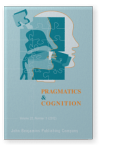Vol. 20:3 (2012) ► pp.505–545
Co-ordination of spatial perspectives in response to addressee feedback
Effects of perceived addressee understanding
In this paper we investigate the effect of level of understanding revealed by feedback in the form of clarification requests from a route follower on a route giver’s spatial perspective choice in their response in route instruction dialogues. In an experiment varying the level of understanding displayed by route follower clarification requests (the independent variable), route giver perspective switching in response to this feedback is investigated. Three levels of understanding displayed by feedback are investigated: (1) low-level clarification requests indicating that the instruction was not processed, (2) semantic-level clarification requests indicating that the spatial direction given in the instruction could not be resolved as the speaker of the clarification request could not interpret which perspective was intended, and (3) high-level feedback which indicates that the route giver’s instruction was understood but which note an obstacle to following the instruction. Results show that perspective choice, which is a conceptual feature of language use, is sensitive to perceived level of addressee understanding. We found that route givers consistently switch perspectives in responding to semantic-level clarification requests but not in response to low-level ones, and also that switching occurs more for high-level feedback than for low-level feedback. We address how dialogue systems can take advantage of these findings by modelling our results in an Information State model of dialogue, presenting update rules for response generation which account for our findings and also update rules which enable generation of the feedback themselves.
